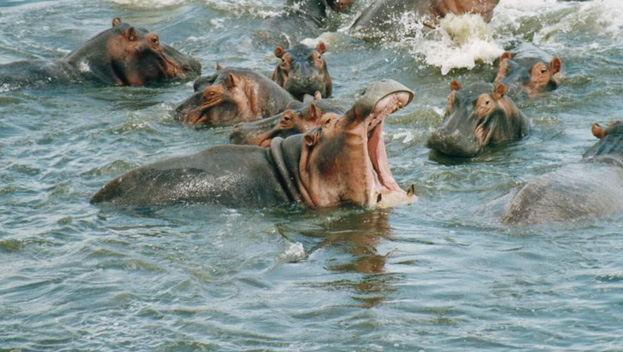
Majete is Malawi’s premier wildlife destination. Experience the full wonder of Malawi Majete Wildlife Reserve, restored to diverse abundance with thriving animal populations and plentiful birdlife.
Majete is an incredible conservation success story – becoming one of Malawi’s premier parks with thriving animal populations and plentiful birdlife.
Majete Wildlife Reserve is a stunning 70,000-hectare protected are located in the south-western part of Malawi with an unlikely story of resurgence and restoration. Established in 1955, the reserve has undergone a remarkable transformation in recent years, once being heavily poached and degraded today Majete puts Malawi on the world map as a coveted wildlife destination and a haven for endangered species such as the black rhino and African Elephant, as well as being a Big Five destination in Malawi. With its breathtaking scenery and successful conservation efforts, Majete Wildlife Reserve is a must-visit destination.
Majete Wildlife Reserve serves as a model for successful conservation efforts in Malawi and highlights the importance of preserving natural habitats for the benefit of both wildlife and local communities. By focusing on sustainable practices and eco-tourism, Majete not only protects endangered species but also supports economic development in the region. The conservation work being done in Majete serves as a shining example of how wildlife reserves can make a positive impact on both the environment and society.
The 70,000-hectare reserve become Malawi’s first ‘Big Five’ game reserve (referring to African buffalo, African elephants, African leopards, lions and rhinoceros) when the non-profit conservation organization African Parks reintroduced lions in August 2012. Other mammals in the park include common eland, duiker, hippopotamus, impala, monkeys, nyala, reedbuck, sable and other antelopes, warthogs, waterbuck and zebras. Reptiles include crocodiles and tortoises. Birds include the African finfoot, Bohm’s bee-eater, Egyptian goose, and racket-tailed roller, as well as other in the order Anseriformes. Recorded arachnid species include the golden silk orb-weaver.
Accommodation
Majete Wildlife Reserve offers a variety of options, from luxury lodges to budget friendly camps, providing visitors with a range of choices to suit their preferences. The accommodations are designed to blend in with the natural surroundings, offering a unique and engaging experience for guests. Visitors to Majete can enjoy and experience a peaceful retreat in the heart of the African bush while supporting conservation efforts and the local communities. �
Mkulumadzi Lodge
Mkulumadzi Lodge is an exclusive luxury lodge in Southern Malawi set on a rush riverbank within Majete Wildlife Reserves. It enjoys an idyllic location at the confluence of two rivers shaded by giant leadwood trees.
It is the perfect combination of splendid isolation and first-class facilities. Undiscovered by tourists, Majete is s a true wilderness where every trip into the bush with the team of experienced guides feels like an adventure.


Thawale Lodge
A classic tented camp at the gateway to Majete Wildlife Reserves. Thawale Lodge is set on the edge of a pristine waterhole that regularly attracts variety of wildlife.
The lodge is completely unfenced to give guests a unique experience in the natural surrounds. Thawale is a peaceful haven to experience Majete Wildlife Reserves.
Activities and Experiences
Majete Wildlife Reserve offers a variety of wildlife experiences, including game drives, walking safaris, and boat trips on the Shire River (though boat trips are currently unavailable due to damage from a flood).
Visitors can explore the reserve's diverse landscapes and wildlife, with opportunities to spot the Big 5 and numerous other species. The reserve also offers community visits and cultural experiences.
Bird Watching
Majete Wildlife Reserve offers a great bird watching experience.
The reserve is home to over 300 bird species and is home to four species of vulture and there is a big concentration of the bateleur eagle to mention just a few.
Enjoy a dedicated birding drive in an open-air game viewing vehicle with a specialist bird guide to see some of the 300 species in the reserve.


Game Drives
Morning & Sundown Game Drives take advantage of the cooler hours, while the latter include sundowners at sunset and a chance to see some of the nocturnal wildlife.
All are conducted by experienced and knowledgeable safaris guides.
Self-drive or guided 4WD game drives are available to explore the reserve and spot wildlife, including the Big 5.
Boat Safaris
Get a unique perspective of Majete from the Shire River. This afternoon activity stops for sundowners on the riverbank and gives you a chance to sport some riverine life – even elephants coming to drink. Subject to seasonal availability.
(Temporarily unavailable) Take a boat trip on the Shire River to observe hippos, crocodiles, and various bird species.


Community Visits and Cultural Performances
Opportunities to interact with local communities and experience their culture, including cultural dancing performances.
Experience the “warm heart of Africa” by meeting and interacting with local communities, learning more about their traditional lifestyle from sampling traditional foods to enjoying local dances.
Walking Safaris
Guided walks provide a more intimate experience, allowing guests to learn about the flora and fauna up close. While on a walking safari, your guides will be extremely vigilant about established safety procedures.
The chance of encountering dangerous animals (which will be given a wide berth) is far less than during a game drive.

Best Time to Visit
Majete is open all year-round, the weather conditions vary considerably depending on season.
The wet season occurs from November to March and is when Malawi receives most of its seasonal rains. It is hot and humid with thick lush vegetation.
In contrast, the dry season runs from April to October when the bush gets increasingly less green and temperatures are mild to very hot come October.
The period is ideal for viewing wildlife as they congregate around remaining water sources, making it easier for visitors to spot a variety of animals.
Rain is unlikely from June – October. Temperatures range from 11 to 40 degrees Celsius, with July being the coolest, and October/November being the warm months.
